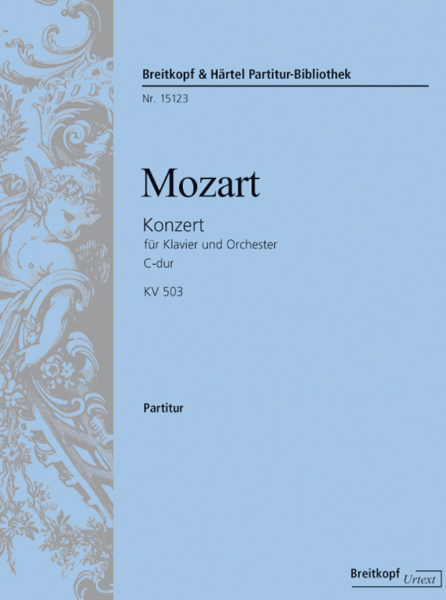Wolfgang Amadeus Mozart (1756–1791) Klavierkonzert [Nr. 25] C-dur KV 503
Urtext herausgegeben von Ernst Herttrich [Klav,Orch] Dauer: 33'
Solo: Klav – 1.2.0.2 – 2.2.0.0 – Pk – Str
In Kooperation mit G. Henle Verlag
EB 10825 ist in Partitur gedruckt; zur Ausführung werden zwei Exemplare benötigt.
Unsere
Ausgabe EB 8579 enthält eine Ferruccio Busoni Kadenz zum Klavierkonzert C-dur KV 503.
Nachdem Sie die gewünschten Ausgaben in den Warenkorb gelegt haben, können Sie dort die benötigte Stückzahl bei Bedarf noch anpassen.
Das C-dur-Konzert KV 503 erfreute sich der besonderen Wertschätzung des Komponisten, der es z. B. 1789 drei Jahre nach seiner Entstehung auf das Programm seiner Akademie im Leipziger Gewandhaus setzte. Die Neuausgabe basiert auf dem Autograph und berücksichtigt auch den 1797 von Constanze Mozart auf eigene Kosten publizierten Erstdruck.
Für die editorische Qualität der Neuausgabe bürgen nicht nur Schiffs ausgefeilte Fingersätze und seine stilsicheren Kadenzen, sondern auch der Mozart-Spezialist Ernst Herttrich, den der Henle-Verlag mit dieser Urtext-Edition betraut hat.
Jedes Werk wird von einem Experten nach einheitlich festgelegten Richtlinien herausgegeben. Dabei werden in erster Linie Mozarts handgeschriebene Partituren als wichtigste Quellen herangezogen. In manchen Fällen waren diese zum Zeitpunkt früherer Editionen noch nicht zugänglich. Heute weiß man außerdem, dass neben den Autographen auch frühe Stimmenabschriften und Drucke wichtige Informationen zum Notentext enthalten.
Nach Wolfgang Amadeus Mozarts eigenen Angaben in seinem Verzeichnüß aller meiner Werke wurde das C-dur-Klavierkonzert KV 503 am 4. Dezember 1786 vollendet. Aufgrund von Papier- und Wasserzeichenuntersuchungen konnte jedoch nachgewiesen werden, dass er das Werk bereits zwei Jahre früher, im Winter 1784/85, begonnen und dann zunächst liegengelassen hatte (Alan Tyson, Mozart. Studies of the Autograph Scores, Cambridge, Mass. 1987). Für die Adventszeit 1786 plante Mozart einen Zyklus von vier neuen Akademien im Trattnerschen Kasino, für die er sich das C-dur-Konzert offenbar wieder vornahm und nun auch vollendete. Die Uraufführung spielte er selbst, wahrscheinlich am Dienstag, den 5. Dezember 1786. Das Konzert ist allerdings dokumentarisch nicht belegbar. Eine weitere Aufführung des Konzerts fand möglicherweise am 7. März 1787 im Kärtnertor-Theater bei einer Akademie der Pianistin Maximiliana (Marianne) Willmann statt, die angeblich eine Schülerin Mozarts war. Zwar steht nicht genau fest, welches Konzert sie dort spielte, es liegt jedoch nahe, dass es sich um das neue in C-dur KV 503 handelte. Am 12. Mai 1789 schließlich veranstaltete Mozart auf seiner Reise nach Berlin gemeinsam mit Josepha Duschek eine Akademie im Leipziger Gewandhaus und setzte dabei auch das C-dur-Konzert auf das Programm (dazu noch das Klavierkonzert KV 456, die Klavierfantasie KV 475 und die beiden Sopran-Szenen KV 505 und 528). In erster Linie ging es Mozart dabei vermutlich darum, dem Leipziger Publikum ein neues, noch ungedrucktes Werk vorzustellen. Aber sicher ist die Wahl von KV 503 auch Ausdruck einer besonderen Wertschätzung, die er für diese Komposition – sein längstes Klavierkonzert überhaupt – hegte.
Außer dem wie bei Mozart üblich sehr sauber geschriebenen Autograph ist zu KV 503 noch ein Skizzenblatt erhalten, auf dem unter der Überschrift „Mittelgedanken“ Skizzen zu mehreren Stellen aus dem Kopfsatz des Konzerts notiert sind. Eine davon betrifft die Passage zwischen dem ersten Soloteil und dem danach wieder einsetzenden Orchestertutti (Takte 96ff.), die im Autograph durchgestrichen und auf der nächsten Seite neu ausgeschrieben ist. Einmal mehr wird dadurch die oft kolportierte Annahme widerlegt, Mozart habe seine Autographe immer in einem Guss und „aus dem Kopf“ niedergeschrieben, seine Werke seien ihm gleichsam „zugeflogen“. Vielmehr dokumentiert die Skizze die enorme geistige Arbeit, die Mozart bei der Notierung seiner Partituren leistete.
KV 503 ist zu Mozarts Lebzeiten nicht im Druck erschienen und teilt damit das Schicksal des Großteils seiner Klavierkonzerte. Lediglich vier davon – KV 413–415 und KV 450 – hat Mozart selbst veröffentlicht. Offenbar gehörten die Konzerte in seinen Augen zu den exklusiven Werken, die „ich für mich, oder für einen kleinen zirkel liebhaber und kenner |: mit dem versprechen sie nicht aus händen zu geben :| zurückbehalte“ (Brief vom 30. September 1786 an den Kammerdiener des Fürsten von Fürstenberg zu Donaueschingen, Sebastian Winter). KV 503 war eines der letzten Klavierkonzerte, das im Druck erschien, und zwar erst 1797 im Eigenverlag der Witwe Constanze Mozart. Sie hatte, wie aus einem Brief an den Offenbacher Verleger Johann André hervorgeht, die Veröffentlichung bereits seit 1795 geplant und das Werk schließlich auf eigene Kosten stechen lassen. Die Ausgabe ist Prinz Louis Ferdinand von Preußen gewidmet und enthält auf dem Titelblatt den Hinweis (auf Italienisch), dass sie auf Kosten der Witwe publiziert und bei allen guten Musikalienhändlern zu haben sei. Über die besondere Bedeutung dieser Ausgabe und über die darin enthaltenen Abweichungen vom Autograph gibt der Kritische Bericht am Ende dieser Edition detailliert Auskunft.
Die Staatsbibliothek zu Berlin – Preußischer Kulturbesitz stellte freundlicherweise sowohl Kopien des Autographs und des Skizzenblattes als auch der Erstausgabe zur Verfügung, wofür ihr an dieser Stelle herzlich gedankt sei.
Berlin, Frühjahr 2011











